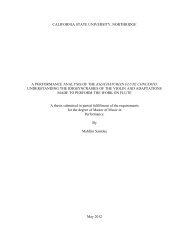Page 1 The California ""- Geographer Annual Publication of the ...
Page 1 The California ""- Geographer Annual Publication of the ...
Page 1 The California ""- Geographer Annual Publication of the ...
Create successful ePaper yourself
Turn your PDF publications into a flip-book with our unique Google optimized e-Paper software.
Except for <strong>the</strong> various changes mentioned earlier in this paper <strong>the</strong><br />
climatic areas on <strong>the</strong> accompanying map (Figure 1) were determined by<br />
use <strong>of</strong> Koppen's classification system and any formulas that he devised to<br />
be used with it (see Figure 3). <strong>The</strong> only exception to this could possibly<br />
be <strong>the</strong> "n" or foggy climates, to which Koppen attached no quantitative<br />
limit. This author tentatively attached a limit <strong>of</strong> 30 days each year with<br />
dense fog (as defined by <strong>the</strong> U.S. Wea<strong>the</strong>r Bureau) to be used to delimit<br />
<strong>the</strong> "n" areas. Previous climatic maps <strong>of</strong> <strong>California</strong> have been much<br />
too conservative in delimiting this foggy region. For example, Russell, in<br />
his 1926 classification failed to include Santa Maria in <strong>the</strong> fog belt.11<br />
Eureka, included by Russell as an "n" area, has only 49 days a year <strong>of</strong><br />
dense fog, while Santa Maria A.P. has 88 days.<br />
An effort will not be made to go into <strong>the</strong> location and explanation <strong>of</strong><br />
each <strong>of</strong> <strong>the</strong> remainder <strong>of</strong> <strong>the</strong> fifteen separate climatic regions plotted on<br />
<strong>the</strong> climatic map that accompanies this paper (Figure 1). All <strong>of</strong> <strong>the</strong> symbols<br />
used on <strong>the</strong> map can be interpreted with <strong>the</strong> use <strong>of</strong> <strong>the</strong> information<br />
in Table 7 and Figure 3. Where no climatic data were available <strong>the</strong><br />
criteria <strong>of</strong> elevation, vegetation cover, nearby stations, and knowledge <strong>of</strong><br />
<strong>the</strong> landscape by <strong>the</strong> am·thor and o<strong>the</strong>rs were used to determine parts <strong>of</strong><br />
some <strong>of</strong> <strong>the</strong> climatic boundaries. As more data becomes available in <strong>the</strong><br />
future such "second-bests" as mentioned above can be eliminated. This<br />
map is certainly subject to revision as such additional information shows<br />
changes should be made.<br />
n Russell, op. cit., climatic map.<br />
Notes for Table 7 on opposite page.<br />
"See Figure 3 for graph showing Koppen's boundaries between semi·arid,<br />
arid and humid climates.<br />
"""s": Summer dry; at least three times as much precipitation in <strong>the</strong> wettest<br />
month <strong>of</strong> winter as in <strong>the</strong> driest month <strong>of</strong> summer; also <strong>the</strong> driest month <strong>of</strong><br />
summer receives less than 1.20 inches <strong>of</strong> precipitation.<br />
10













